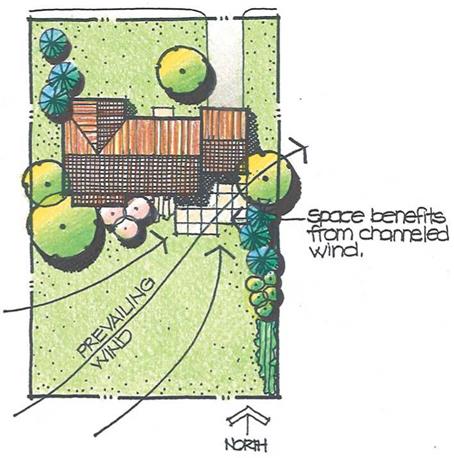Wind is also a potential asset in most regions. During the hot season of the year, air movement enhances the evaporation of moisture from people’s skin and thus gives the perception of cooler air temperatures. Additionally, wind prevents the air in outdoor spaces from becoming too stagnant. The exception to this occurs in hot, arid climates where hot-season wind can magnify the perception of extreme temperatures rather than diminish them. There are a number of means of capturing and taking advantage of the possible benefits of wind on a residential site.
 |
 |
One is to provide generous open lawn or meadow areas to the south and southwest of the house and in outdoor spaces used in the warm season (Figure 3—34). Such an open area will permit the prevailing wind to move toward the house or outdoor
space without obstruction. Similarly, plant materials and other elements of height should be kept low to the south and southwest sides. Areas of ground cover, low perennials, or shrubs below 2 feet will give maximum exposure to wind.
Channeling air movement can further enhance wind exposure. As with coniferous plants, wind is deflected in all directions around the canopy mass of a large deciduous tree; some wind is directed below the canopy where wind velocity is intensified between the canopy and the ground. Increased wind speed and shade make the space below a tree canopy feel cooler, an occurrence regularly appreciated by players who seek respite under a tree on a golf course on a hot summer day. To take advantage of this possibility on a residential site, deciduous shade trees should be located near the south or southwest side of the house or outdoor space (Figure 3—35).
The planned arrangement of vegetation, walls/fences, and landform, either singularly or collectively, can likewise funnel wind toward the house or outdoor spaces. These elements can be located in a broad V-shaped configuration that directs the prevailing wind to a specific area (Figure 3—36). When channeling wind, the surface material the wind is blowing over before it enters the house or outdoor space should be kept in mind. It is best to allow the wind to move across a vegetated surface such as lawn or ground because air temperatures above this type of ground material are comparatively cool. When possible, it is likewise desirable to allow wind to move over water such as a lake, pond, or even small water features such as a pool or waterfall. It is not wise to permit wind to move across a paved surface such as a parking lot or driveway because air temperatures above these areas are relatively high. These extreme temperatures are then transferred to the adjoining house or outdoor space.
Figure 3-35
A deciduous shade tree can channel wind and provide shade for the outdoor space and house located beneath it.
 |
|
PKHAIL! MQ
![]()
 /n-tensified wind veloci+м
/n-tensified wind veloci+м
![]()
|

Fences and walls can also enhance exposure to wind. As previously discussed, a wall or fence can be designed to direct the wind in different ways around and through an outdoor space. To assist wind exposure, a wall or fence should be designed with generous openings. An open wrought-iron fence or open grid of different materials allows maximum exposure to wind while also providing enclosure by the fence. A louvered fence is frequently an excellent approach as well. Louvers in a fence may be designed to swivel or turn so that they can be adjusted to affect the size and orientation of the openings. This allows the fence to respond to varying wind directions and velocities.
In summary, numerous techniques can be implemented on the residential site for properly designing with wind. Each needs to be analyzed with respect to the existing regional and specific site conditions to determine its feasibility and potential impact. These techniques should be coordinated with consideration for sun and other requirements of the site (see previous sections of this chapter). Using some or all of these means for designing with wind will ultimately benefit the quality of a residential site design and its associated enjoyment of use by the homeowners.



